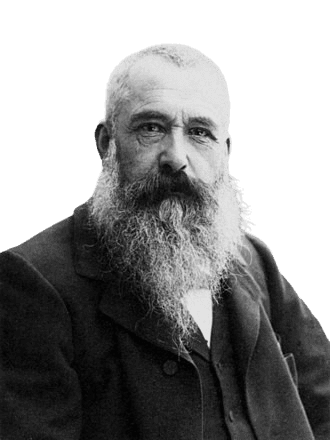Life and achievements
Early life
The painter Claude Monet was born on November 14Paris, France. Born in Le Havre, Normandy, Monet became interested in drawing and the natural world at a very young age. His mother, Louise-Justine Aubrée Monet, encouraged him to become an artist, while his father, Claude Adolphe, wanted him to take over the family grocery business. However, Monet chose art and made caricatures and portraits for a living.
Monet's initial training in art was at the Académie Suisse and then under the academic history painter Charles Gleyre in Paris. Here, he got acquainted with other Impressionist painters of the future, such as Auguste Renoir. However, the most significant impact on the development of Monet's style was made by Eugène Boudin, who revealed the artist to the principles of plein-air painting. Boudin's encouragement to paint en plein air helped Monet to perfect his observation of light and the natural environment.
Monet was conscripted into the army in 1861 and sent to Algeria, where he was impressed by bright colours and glaring light. He left the military and returned to Paris, where he further enhanced his style. The Salon's rejection did not deter Monet; he, with the help of others, started the Anonymous Society of Painters, Sculptors, and Engravers, which later became the Impressionist group.
Legacy
Monet's contribution to the art world is immeasurable. His works impacted the development of modern art and motivated many artists. Monet was considered one of the Impressionists who focused on light, colour, and the representation of the natural world, thus paving the way for future artists. His new techniques of painting en plein air enabled artists to discover new ways of representing the world.
Monet's work contributed much to the evolution of abstract art; his later works, especially the Water Lilies series, depicted a certain level of abstraction that informed artists like Pollock and Rothko. Monet's commitment to his art, even in the face of sickness and poverty, showed that passion and hard work pay off in achieving excellence in one's work.
The preservation and restoration of Monet's house and gardens in Giverny have made it possible for the world to honour Monet even today. The site is open to the public and gives a feel of the environment in which he painted some of his most famous pieces. Monet's impact does not only end in the art world, as his name is associated with the beauty and serenity of Impressionist paintings.
The influence of Monet in the art world is seen through the analysis and display of his artworks even to this date. His paintings are displayed in museums and galleries across the globe, making it easy for his work to be recognized and admired by generations to come. As one of the most significant artists of the Impressionist movement and the creator of some of the most exquisite works that portray the transient beauty of nature, Claude Monet is still considered a genius.
Join Confinity and create a lasting digital legacy, just like history's greatest minds. Signup Now
Learn how this historical figure's legacy continues to shape our world today →
Milestone moments
Apr 9, 1851
Monet joins Le Havre Secondary School of the Arts
Monet was first introduced to formal education in the arts at the age of ten when he joined the Le Havre Secondary School of the Arts.
Monet's early education was in traditional drawing methods, which he mastered before moving on to caricaturing people.
He was able to depict the characters' personalities and their features with wit and accuracy, which brought him fame and wealth.
Oct 24, 1862
Painting with Charles Gleyre in Paris
Monet enrolled at Charles Gleyre's studio in Paris, where he worked with Renoir, Sisley, and Bazille.
This period is considered the start of Monet's interaction with the future Impressionists, as they discussed and exchanged ideas and methods that would become characteristic of them.
Monet's artistic growth was aided by the culture of collaboration he adopted, abandoning traditional academic styles for more unconventional ones.
Oct 22, 1872
Creation of "Impression, Sunrise"
Monet created the painting "Impression, Sunrise," which portrayed the harbour of Le Havre; this painting led to the naming of the Impressionist movement.
The painting is characterized by a free brush application and a tendency to depict the ephemeral play of light and color, which was quite new for the genre of landscape painting.
" Impression, Sunrise" was painted in 1872 and shown in 1874 at the first Impressionist exhibition, which was welcomed with criticism and created a new art form.
Jun 9, 1870
Marriage to Camille Doncieux
Monet married Camille Doncieux, his lifelong companion and model, which was a significant event in his personal life.
Notably, many of Monet's paintings, portraits and scenes from domestic life are dedicated to Camille and their life together.
Their marriage was not without financial problems, but Camille played a significant role in Monet's career development.
